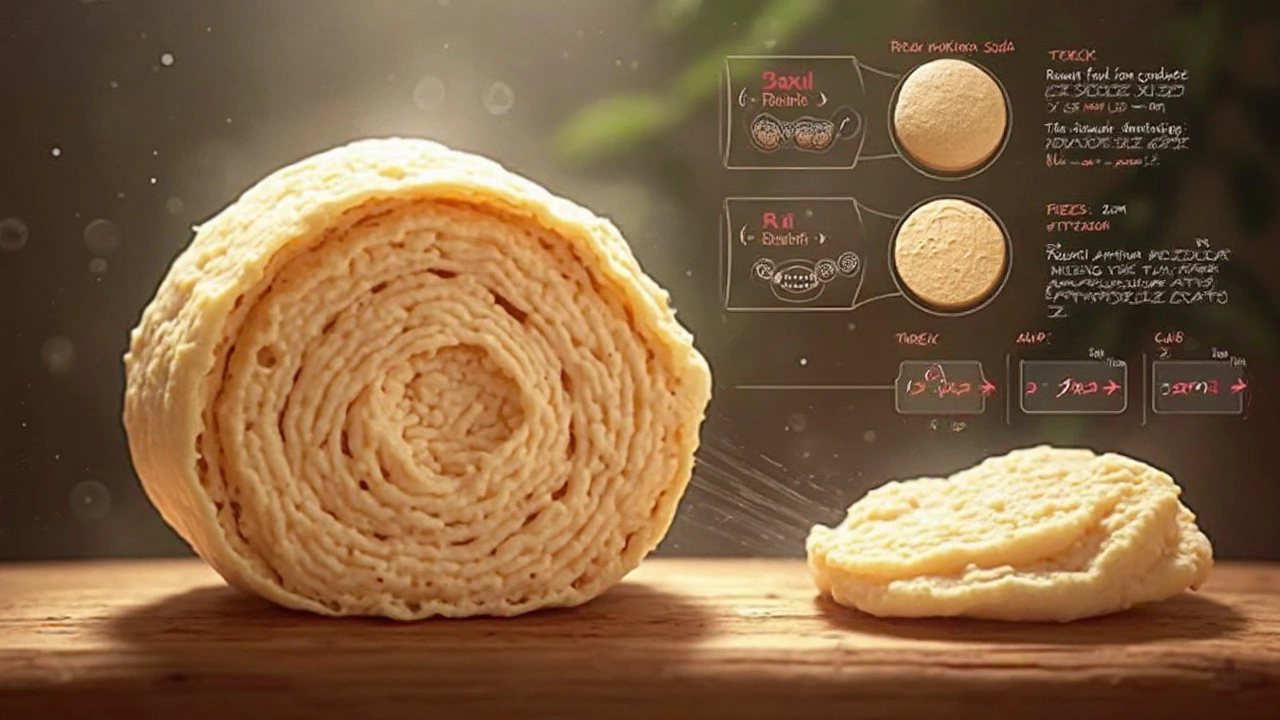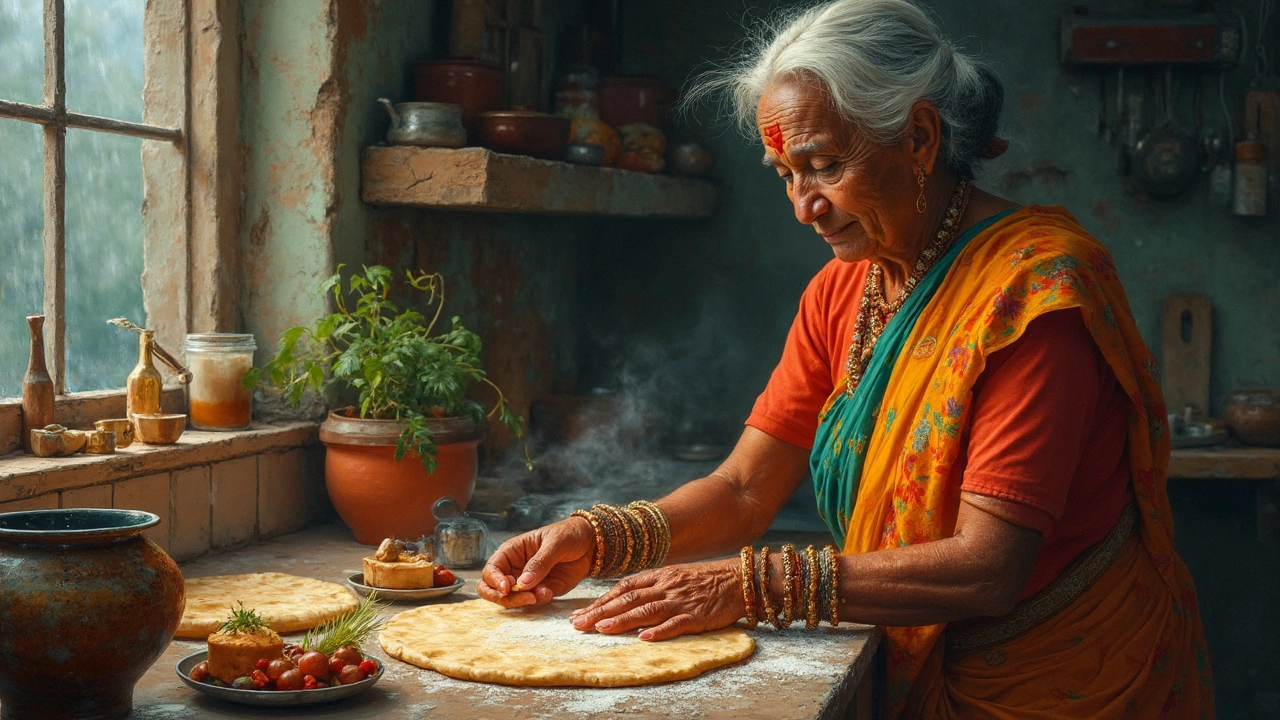Ever wondered how to make your roti just a bit softer and more delightful to eat? Well, you might have heard about using baking soda. There's quite an interesting chemistry behind why a pinch of this humble ingredient could work wonders.
First things first, roti's texture often depends on the right balance of moisture and flour type. But adding in baking soda? That's like giving it a gentle boost with some science magic. Baking soda acts like a leavening agent, releasing carbon dioxide, which helps create tiny bubbles in the dough and leads to that soft, airy feel.
But don’t go overboard. Too much baking soda and your roti might taste odd and have a strange texture. Just a small pinch in your dough mix can subtly enhance softness.
- Understanding Roti Texture
- Baking Soda and Its Properties
- The Science Behind Softness
- Practical Tips for Roti Perfection
Understanding Roti Texture
Getting that perfect balance of softness and chewiness in roti can sometimes seem like a mystery. But it's really about understanding a few important factors that influence texture. Each ingredient plays a specific role, from the type of flour you use to the amount of water in the dough.
Flour type is crucial. Many people prefer using whole wheat flour, also known as atta. It's got just the right amount of protein to help form gluten, which is essential for a stretchable and pliable dough. The gluten network helps trap the air, giving the roti that lovely puff.
Moisture and Kneading
Getting the water ratio right is like hitting the jackpot. Too much water, and you'll have sticky, hard-to-manage dough. Too little means your roti will end up dry and stiff. The trick is to make it soft but not sticky. Kneading helps develop gluten, so give your dough a good 10-minute knead or until it's smooth.
Cooking Process
Cooking roti on a tava or griddle also matters. Preheating the griddle ensures that roti puffs up, sealing moisture inside. Flip it at the right time, usually when small bubbles appear on the surface, for an even cook.
Additions and Adjustments
Even a tiny amount of baking soda can make a big difference. It helps by reacting to the natural acids in the dough, giving it a light, airy texture. However, measuring it accurately is key, as too much can overpower the flavor.
Consider these tips like a beginner's guide to experimenting and adjusting till you hit your roti sweet spot. Remember, it's a touch of science mixed with practice. Happy roti-making!
Baking Soda and Its Properties
Baking soda, or sodium bicarbonate, is one of those kitchen staples that does more than just keep your fridge smelling fresh. It's an alkaline compound, meaning it can neutralize acids—a little detail that comes handy while cooking. When mixed with acidic ingredients, it reacts to release carbon dioxide gas. That’s where it all begins for creating those soft, airy textures in foods, including your beloved roti.
So how does it work? Imagine your roti dough as a tiny bubble of flour and water. By adding a bit of baking soda, you start a chemical reaction that pumps gas into the dough, forming bubbles. It's those bubbles that help make the roti fluff up when you cook it, creating that coveted softness.
How Much Is Just Right?
Precision is key with baking soda. Too much and your food could taste metallic or soapy, not exactly what you’d want! Typically, just a pinch or about 1/8 teaspoon should be enough for a standard dough batch intended for a couple of rotis.
Versatility in the Kitchen
Beyond just roti, baking soda plays a role in everything from cakes to cookies to savory dishes. Its leavening power is particularly useful in quick breads, where you don’t have the yeast to rely on for rising.
Common Mistakes to Avoid
- Don’t confuse it with baking powder—baking soda is stronger and requires an acid to activate.
- Make sure it's well mixed into your dough; you don’t want clumps.
- Remember it loses potency over time, so keep your stash fresh for best results.
In the world of soft roti, this simple ingredient can make all the difference. By understanding its properties and how to use it properly, you’re well on your way to mastering the art of softer, fluffier roti.

The Science Behind Softness
Let’s jump into the nitty-gritty of what makes baking soda so effective for making roti soft. At its core, baking soda is a leavening agent. It's made up of sodium bicarbonate, a chemical compound that reacts with acidic ingredients. When it comes into contact with moisture and acid, it starts releasing carbon dioxide.
Why Carbon Dioxide Matters
That carbon dioxide is crucial because it creates small bubbles within the dough. These bubbles act like little pillows, giving the roti a fluffier and airier texture than it would have otherwise. It's kind of like the magic behind why your favorite bread is airy instead of dense.
You know how sometimes roti feels a bit tough? A bit of baking soda can alter that texture. The key is that it helps to alter the gluten structure of the dough, so your roti is less chewy and more tender.
Balancing Act
Don't overdo it, though. Too much baking soda means too much CO2, which can make the dough rise too quickly and then collapse, resulting in a flat finished product. Plus, excessive baking soda can leave a bitter taste. It’s all about finding the right balance to complement the natural flavors of your ingredients.
Adding Acidity
If you're mixing in yogurt or buttermilk with your flour, you're doubling down on that acidity base, enhancing baking soda's effectiveness. This is where the magic really happens! Those acidic ingredients work well with baking soda, bumping up the softness and even adding a slight tang.
In summary, the secret is in the chemistry that happens as you blend your ingredients. A pinch of baking soda might just be what you need to elevate your bread game!
Did You Know?
| Ingredient | Effect on Dough |
|---|---|
| Baking Soda | Produces CO2 for soft texture |
| Yogurt | Enhances acidity for better leavening |
Practical Tips for Roti Perfection
Getting that perfect roti feels like a small victory in the kitchen. You know, that soft, fluffy texture we all crave for? Here’s how you can achieve it without any fuss.
1. Ingredients Matter
Start with quality flour. Whole wheat flour is your go-to, but experiment with different brands until you find the one that feels just right for you. Some branded flours have finer ground grains, which can make your roti soft and nice to the bite.
2. The Role of Water
Don’t just splash in water; be precise. Using warm water can yield a softer dough. It's easier than you think! Measure gradually. After all, getting that perfect consistency is similar to finding the right rhythm in a dance.
3. Mastering the Dough
A perfect dough should be pliable, not gooey. Knead for about 8-10 minutes – it's worth it. A good thumb rule is to let it rest for at least 15-20 minutes, covered with a damp cloth. This resting phase is crucial if you're using that pinch of baking soda in your mix. It allows the dough to relax and rise a bit, aiding in that fluffiness.
4. Roll and Cook Right
When rolling out your dough, aim for uniform thickness. Use a rolling pin gently and keep it even. Pay attention to the heat on the stove. Ideally, the pan should be heated to medium. Too hot, and your roti might feel more like crisps; too low, and it could turn rubbery.
5. The Final Touch
As soon as you take it off the pan, dab a little bit of butter or ghee on your roti and cover it with a cloth. That little step locks in moisture, keeping the roti soft for longer.
6. Baking Soda Wonders
Lastly, remember that baking soda is your silent helper. Too much and it’ll mess with the taste, but just the right amount – and you’ve got yourself a soft winner.
Try these tips, and soon, you'll effortlessly whip up soft roti, invoking those homemade vibes of pure joy.
